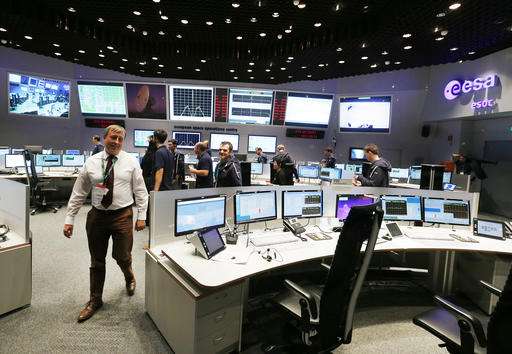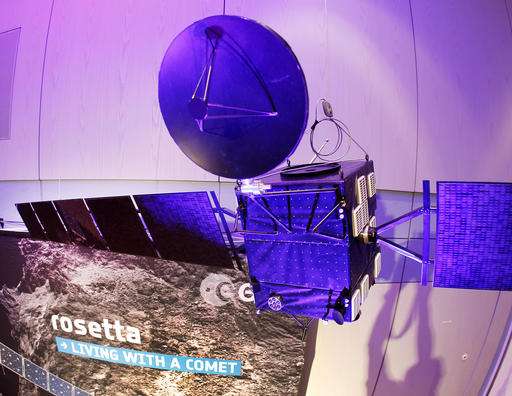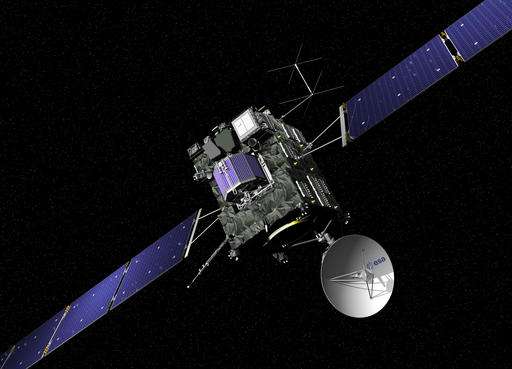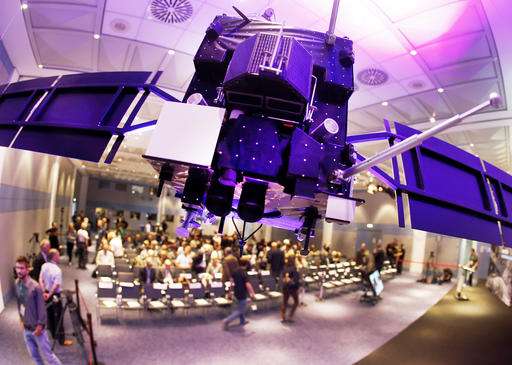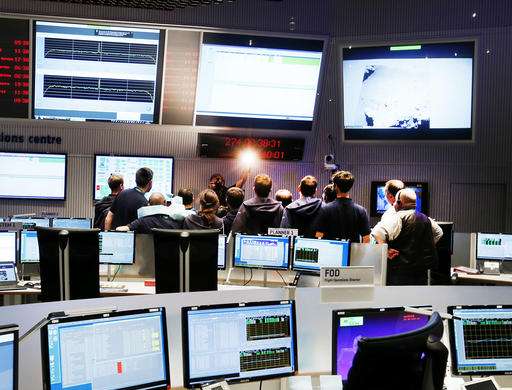Picture shows view into the control room at the European Space Agency sea in Darmstadt, Germany, Friday, Sept. 30, 2016. Rosetta will be impacted on comet 67P/Churyumov-Gerasimenko on Friday, marking the end of the twelve years lasting Rosetta mission. (AP Photo/Michael Probst)
It's been 4,595 days since the Rosetta space probe was lifted into orbit on the first stage of its 12-year mission to chase down comet 67P/Churyumov-Gerasimenko.
Here is a look at some of the other numbers, big and small, surrounding the mission:
___
SPACE ODYSSEY
As journeys go, this one was epic. According to the European Space Agency the Rosetta probe has travelled some 7,971,290,298 kilometers (4,953,359,791 miles) during its lifetime—almost 21,000 times the distance from the Earth to the moon.
___
HIGH-SPEED CHASE
In order to catch up with a comet the Rosetta probe had to swing around Earth and Mars, using the planets' gravity to pick up speed. That's because 67P is flying through space at a breathtaking pace of up to 34 kilometers per second (21 miles per second).
___
DUCK SHAPE
As Rosetta got close to 67P scientists were surprised to see that the comet is made up of two 'lobes' connect by a thin neck, prompting some to liken its shape to that of a rubber duck. While big for a duck, it's still small by cosmic standards: just 4.1 kilometers (3 miles) across at the largest point. The comet weighs some 10 billion metric tons (11 billion tons), though it is steadily losing matter as it hurtles through space.
A model of orbiter Rosetta hangs from the ceiling in a conference room at the European Space Agency ESA in Darmstadt, Germany, Friday, Sept. 30, 2016. Rosetta will be impacted on comet 67P/Churyumov-Gerasimenko on Friday, marking the end of the twelve years lasting Rosetta mission. (AP Photo/Michael Probst)
___
TIN CAN
Compared with the comet, Rosetta is tiny. The span of its solar wings is 32 meters (105 feet) from tip to tip. The probe itself measures just 2.8 x 2.1 x 2 meters. Philae is even smaller—just 1 cubic meter, or about the size of a washing machine.
___
SOLAR FLY-BY
Comet 67P follows an elliptical course that takes it from close to Jupiter's orbit—some 850 million kilometers (528 million miles) away from the sun—almost to Earth's orbit, about 186 million kilometers (115 million miles) from the sun, and back over the course of 6½ years.
The artist impression provided on the website of the European Space Agency ESA on Sept. 29, 2016 shows ESA's Rosetta cometary probe. The spacecraft will be crash landed on Comet 67P/Churyumov-Gerasimenko Sept. 30, 2016. (J. Huart/ESA via AP)
___
VAST TREASURE
The instruments on board Rosetta and Philae have collected a wealth of data that scientists say will take many years to fully analyze. In total the probes sent 218.25 gigabytes of data home to Earth.
___
STAYING POWER
Scientist say that one of the main benefits of the Rosetta mission compared with previous missions—apart from the world's first landing on a comet—was the length of time that the probe spent in 67P's orbit. During its 786 days flying alongside the comet, Rosetta was able to observe its evolution across several 'seasons' as 67P flew toward and then away from the sun again.
-
A model of orbiter Rosetta hangs from the ceiling in a conference room at the European Space Agency ESA in Darmstadt, Germany, Friday, Sept. 30, 2016. Rosetta will be impacted on comet 67P/Churyumov-Gerasimenko on Friday, marking the end of the twelve years lasting Rosetta mission. (AP Photo/Michael Probst)
-
Picture shows view into the control room at the European Space Agency sea in Darmstadt, Germany, Friday, Sept. 30, 2016. Rosetta will be impacted on comet 67P/Churyumov-Gerasimenko on Friday, marking the end of the twelve years lasting Rosetta mission. (AP Photo/Michael Probst)
© 2016 The Associated Press. All rights reserved.
